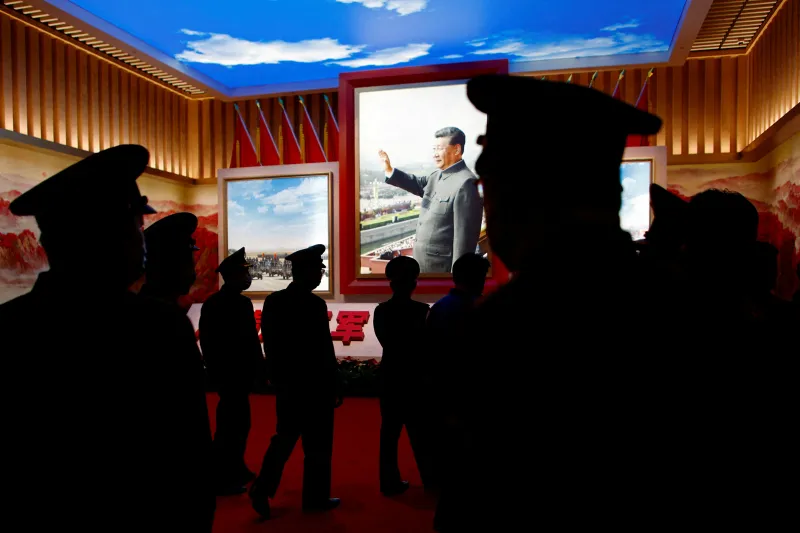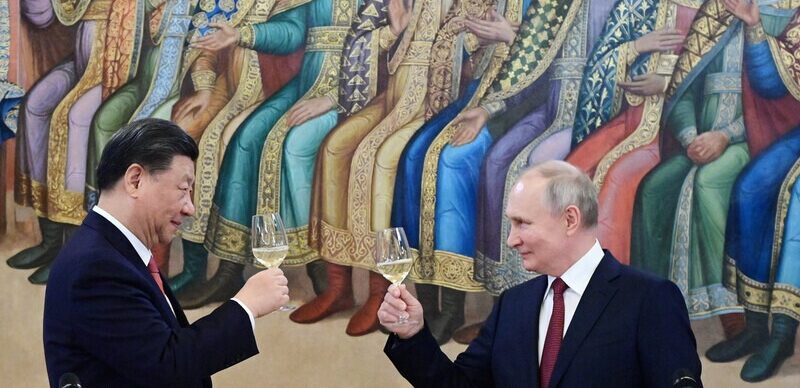How China’s Echo Chamber Threatens Taiwan
FOREIGN AFFAIRS
APLN member Tong Zhao examines how the internal feedback loop among China’s leadership, policy elites, and the general public creates an underappreciated and unaddressed risk of war over Taiwan and what the international community can do to help. Read the original article here.
The risk of a military conflict in the Taiwan Strait is becoming dire. On Feb. 2, CIA Director William Burns stated that Chinese President Xi Jinping had ordered China’s military to be “ready by 2027 to conduct a successful invasion” of Taiwan. Although Burns added that this did not mean that Xi has decided to invade Taiwan, he described Xi’s move as “a reminder of the seriousness of his focus and his ambition.”
But the main factor that will determine whether Washington and Beijing come to blows over Taiwan is not necessarily Xi’s strategy for unification but the idiosyncrasies of China’s political system. The dynamics among China’s political leadership, its policy elite, and the broader public have generated an internal feedback loop that is not entirely within Xi’s comprehension or control. This could result in China’s being fully mobilized for war even without Xi deciding to attack Taiwan.
Xi’s assertive rhetoric, combined with his demand for absolute obedience, has produced an echo chamber in Beijing. His repeated emphasis on the need for unification with Taiwan and his nationwide campaign to encourage the public to “revere the military and admire force” have generated strong political incentives for civilian and military officials to mobilize themselves as if war were inevitable. When Xi spoke at the Chinese Communist Party’s 20th Party Congress last October, his pledge that China “will never promise to renounce the use of force” to achieve unification received louder and longer applause from the over 2,000 party delegates than any other passage in his nearly two-hour speech.
This adulatory reaction is, in turn, causing Xi and other Chinese leaders to be dangerously overconfident. As media outlets muzzle any doubts about the use of force to achieve unification, the leadership could easily perceive a lack of dissent as widespread public support for its aspirations regarding Taiwan. Furthermore, Chinese propaganda agencies’ promotion of anti-American narratives has created a growing sense among the public and policy elite that the United States poses a mortal threat and that a showdown with Washington is inevitable. This puts pressure on Chinese leaders to stress the importance of war preparation, which risks setting the country on a self-fulfilling path to conflict.
Washington and its partners are doing themselves a disservice by assuming that China’s leadership has a coherent strategy on Taiwan, or that Xi’s thinking is the key factor in whether Beijing goes to war. Rather than focusing narrowly on the Chinese president’s current plans, they should think more broadly about the dynamics that reinforce the Chinese public and leadership’s belief that a decisive move on Taiwan may be necessary to defend China’s territorial integrity and break Western containment. And instead of relying solely on deterrence, the United States and other governments should craft their messaging and policies with the aim of disrupting this internal feedback loop.
GOING IN CIRCLES
Xi’s focus on unification has spurred a growing sense of urgency in Chinese society to resolve this issue. The president has described unification as “an inevitable requirement” for the achievement of what he terms “the Chinese Dream of National Rejuvenation,” which he has promised to deliver by 2049—the centenary of the founding of the People’s Republic of China. Unlike China’s previous leaders, who were willing to leave the Taiwan issue to future generations to resolve, Xi aspires to deal with it during his tenure.
Regardless of what these statements indicate about Xi’s specific plan on Taiwan, they have set dynamics in motion that dramatically increase the likelihood of a conflict. China’s political system has become much more centralized under his leadership, and officials, policy elites, and public opinion leaders all face strong incentives to advocate policies that cater to his desires and discourage anything that may be perceived as dissent. As a result, public opinion is shaped by only the most hawkish voices: media outlets now censor anyone who expresses skepticism about a military solution to the Taiwan issue, whereas “patriotic” voices are free to express themselves, even if they promote excessively violent means to advance unification.
China’s policy elites, such as university scholars and think-tank experts, contribute to the internal feedback loop by unconditionally endorsing the righteousness of Xi’s vision for unification. Although these experts acknowledge in private that voluntary unification with Taiwan is no longer feasible, they still embrace Xi’s ambition as their own and have made coercive unification the underlying assumption of almost all policy analyses and recommendations. Few question the wisdom of an accelerated and more assertive unification agenda, and instead focus on generating ideas for how to make it work. They compete with one another to offer innovative solutions for how China can develop the right types of military power, strengthen its economic resilience, and win the international support necessary to achieve unification.
These policy recommendations by scholars and public intellectuals likely reinforce Xi’s belief that his push for unification is morally just and practically feasible. But it also promises to place additional pressures on him: the president’s open antipathy toward U.S. hegemony and democracy promotion has led prominent Chinese experts to put forward theories that the United States is actively seeking a military crisis over Taiwan to contain China’s rise. A widely held belief within China’s expert community is that the United States’ true objective in the Ukraine conflict is to weaken Russia and that it is similarly keen on instigating a military conflict over Taiwan with the goal of gradually eliminating China as its primary competitor. These theories have reinforced a public perception that China faces an existential threat from the United States.
This dynamic creates a popular mandate for China’s top leadership to act assertively. It could potentially compel Xi to seriously consider military action if he perceives that the risks of backing down, in terms of his domestic popularity and political position, are too high. In essence, he is boxing himself in.
Meanwhile, Xi’s demand for political loyalty and his promotion of “fighting spirit” has prevented the Chinese bureaucracy from serving as a check on these impulses. Even diplomats—the doves—have adopted a “Wolf Warrior” persona, using confrontational rhetoric to defend China’s official narratives and assert its rights. This makes it challenging to identify influential domestic actors who can put the brakes on China’s drift toward war mobilization. Additionally, Xi’s emphasis on “self-confidence” has led state media to fixate on China’s achievements in military modernization, feeding the public impression that coercive options are increasingly feasible.
The Chinese public and policy elites are already placing pressure on China’s top leadership to act more forcefully. When House Speaker Nancy Pelosi visited Taiwan in August 2022, Chinese netizens dominated social media with calls for a strong Chinese response. Many of these voices expressed excitement about going to war and subsequently expressed disappointment at what they perceived as an underwhelming response from Beijing. Meanwhile, in private conversations, many senior policy experts who advise the government maintain that unification with Taiwan must be achieved at all costs, even if it means going to war with the United States.
FINDING COMMON GROUND
The Chinese government is not fully aware or in control of these internal dynamics. Having preferred to achieve unification through coercion—but without actually fighting a war—Beijing remains convinced of its peaceful intentions and does not recognize how it currently risks drifting toward war. It is crucial for the United States to refine its approach toward China with these dynamics in mind and understand how certain efforts to deter Beijing can inadvertently exacerbate the security challenge.
When foreign officials describe Beijing’s war plans against Taiwan, Chinese elites and the public perceive these statements as deliberate exaggerations designed to rally a coalition against their country. For example, when U.S. Air Force General Mike Minihan expressed a belief that Xi is likely to attack Taiwan in 2025, it contributed to Beijing’s paranoia that Washington wants to provoke a war in order to weaken China. These fears are becoming increasingly mainstream in Beijing and serve to strengthen China’s resolve to prepare for and win such a confrontation.
China’s internal feedback loop is the product of its ever more centralized and inward-looking system and represents a problem that the country itself must address. But the international community cannot afford to simply ignore these dynamics: overreliance on a military-dominated strategy to counter China in the Taiwan Strait may feed into Beijing’s misperceptions and fears, making deterrence harder to achieve. Instead, foreign countries’ deterrence strategy should consider how China’s internal dynamics shape its interpretation of and reaction to foreign actions. They should also develop a proactive strategy to use reasoning and persuasion to mitigate the perception gap separating Chinese leaders, policy experts, and the general public from their foreign counterparts.
By understanding how certain views are filtered through Chinese society and leadership, the international community can develop more effective tactics to engage the country. For instance, Chinese policy experts’ conviction that China has an unquestionable legal right to use force against Taiwan is a crucial element underlying the leadership and general public’s thinking on coercive unification. Yet Chinese experts have failed to consider contemporary examples that contradict mainstream Chinese understanding of international norms, such as the United Kingdom’s handling of Scotland’s independence vote in 2014 or Canada’s management of Quebec’s referendum in 1995.
Many Chinese experts genuinely believe that their interpretation of international laws and norms is impeccable. As a result, they are interested in debating these issues with their Western counterparts in the hope of convincing them of this. This presents a good opportunity for international legal experts to engage with their Chinese colleagues to build a common understanding about how other countries have dealt with similar issues of national unity. Unfortunately, foreign governments and civil society organizations have not invested in such dialogues despite their potential to be a useful entry point for constructive exchanges.
Chinese policy elites and the public also underestimate the potential consequences of a large-scale military conflict over Taiwan. The lack of credible public research in China on how a conflict would affect the country’s population in the short and long term contributes to Chinese society’s optimistic risk assessment. International think tanks and research institutes can help the Chinese people better understand their own interests by analyzing these issues and promoting the findings. They could also conduct joint studies with their Chinese counterparts, when feasible.
Similarly, Chinese experts currently lack opportunities to reflect on and debate whether an accelerated unification agenda helps or harms China’s national interests. The international research community could provide platforms for these discussions: in expert exchanges and Track II dialogues, international experts should introduce topics that encourage Chinese experts to discuss the logic behind their sense of urgency to unify Taiwan.
The U.S. government should also refine its messaging to counter the misperception that it is blocking unification to hinder China’s successful development and national rejuvenation. When discussing the Taiwan issue, the United States and its allies should emphasize one vital message: that they respect, welcome, and support the Chinese people’s growing contribution to the international community and that achieving a noncoercive resolution to the Taiwan issue is in China’s best interest in order to realize its dream of national rejuvenation. These messages should be conveyed not only to senior Chinese leaders but also to the expert community and the general public. Officials from the United States and many other countries are already making efforts to directly engage with the Chinese public through Chinese social media, and more targeted messaging would enhance these efforts.
Most important, the United States and its allies should not dismiss mainstream Chinese narratives about the threat posed by Western countries as mere propaganda. These narratives largely reflect genuine, if mistaken, beliefs and are becoming more deeply embedded in China’s foreign policy as a result of the country’s internal feedback loop. This challenge cannot be resolved by relying solely on military countermeasures. The international community needs a coherent strategy to dispel misperceptions and convince the Chinese public and leadership of the benefits and feasibility of open-minded, good-faith discussions on the Taiwan issue. Although challenging, this is what it will take to prevent an increasingly likely war—with catastrophic consequences for all.
Image: Members of the Chinese military in Beijing, October 2022




